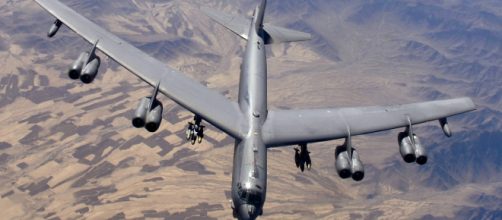The B-52 bomber Stratofortress is the oldest strategic bomber in USAF arsenal, but this 60-year-old bomber remains a vital part of America’s nuclear deterrent. Along with the land-based Minutemen ICBM missiles and the highly secretive Trident nuclear attack submarine, the B-52 form an important part of the America nuclear triad.
Although the B-52 was designed in the 1960s, the USAF has no plans to retire the bomber immediately. Instead, they want it to fly until the 2050s. As part of the plane’s regular updates, the USAF is adding a series of major upgrades to make the bomber relevant and more survivable in the digital battlefield.
The huge upgrades will include a new weapon, improved radar, new computers, new communication links, and new electronic warfare countermeasures.
New weaponry coming
As mentioned earlier by Defense News, the Boeing-built strategic bomber is about to receive some new weapon capabilities for both conventional and nuclear mission. To keep the bomber relevant to the modern-day mission, the USAF has announced plans to spend billions of dollars in the development and deployment of a new air-launched cruise missile or ALCM. Fully loaded, the aging bomber is reportedly capable of carrying 20 of these ALCM weapons, which can be armed with conventional or nuclear warheads.
The USAF has already signed a $900 million contract with defense contractors Lockheed Martin and Raytheon for work on a new, nuclear-capable cruise missile known as the Long-Range Standoff Weapon (LRSO) program.
The LRSO program is a highly classified weapon program. That’s why the service won’t disclose the full cost or exact value of the contract with the two US-based defense contractors. The $900 million contract is part of USAF’s 54-month technology maturation and risk reduction phase to develop a new weapon capability. The service plans to integrate the new weapon with its nuclear-capable strategic bombers the B-52, B-2 and the upcoming B-21. Initial tests are already being planned for the late 2020s, according to the Air Force.
In addition to the new ALCM, the Air Force is also getting a new hypersonic weapon. Last June, the Air Force disclosed that the bomber had been used to carry experimental hypersonic missile on flight tests.
The weapon used, which is called the AGM 183A Air-Launched Rapid Response Weapon (ARRW), did not contain any explosives. Instead, according to the Defense News website, the USAF used the B-52 to gather data about the impact of the weapon on the plan’s flight envelope, the website reported.
Along with the new weapon upgrades, the B-52 will also receive an upgrade to its conventional rotary launcher. The latest upgrades will double the number of weapons the bomber can carry and launch during its mission.
New radar for better detection
The B-52 will also get a new radar, courtesy of a major US defense contractor Raytheon. The new radar system will replace the plane’s current Northrop Grumman-designed AN/APQ-166 system.
In July, the Air Force has announced its selected Raytheon to work a new active electronically scanned array (AESA) radar system. The new radar, which reportedly will be based on Raytheon’s APG-79 and APG-82, will increase the distance at which the bomber can detect targets. The new radar will also increase the number of targets the track and locate. Raytheon will be working with Boeing to build the new radar. The first ground and flight tests are expected to be ready as early as 2023.
New computers and communication links
The Cold War-era bomber will also receive a series of technology updates, which include updated computers, full-color LCD displays, and new communication links. The latest upgrades will allow the plane to stream a real-time feed that will provide the Air Force with crucial intelligence data.
Additionally, the service is also adding the NATO-standard communication link, the Link-16. The service and partner, Boeing, is still working for the modification, but a flight test is already being planned for mid-2020. The Air Force also plane to add the data link of the US Navy’s Mobile User Objective System. This latest communication upgrades will allow the B-52 to communicate with other platforms.
The plane is getting more EW muscle
As for the electronic warfare countermeasures, the Air Force is still figuring out how to modernize the plane’s current electronic warfare system. The service is still looking for a possible replacement or upgrade of its current ALQ-172 electronic countermeasures system.
The Defense News website has learned that the USAF has already discussed a full-scale replacement for the ALQ-172. The Air Force considered their B-52 bomber as a standoff platform and its play a crucial role in America’s security and nuclear deterrence. To survive the challenge of the high-tech digital battlefield, the plane needs a serious electronic warfare upgrade. The huge makeover will increase the plane’s chance of survival when entering high-density threat areas like China’s backyard.


